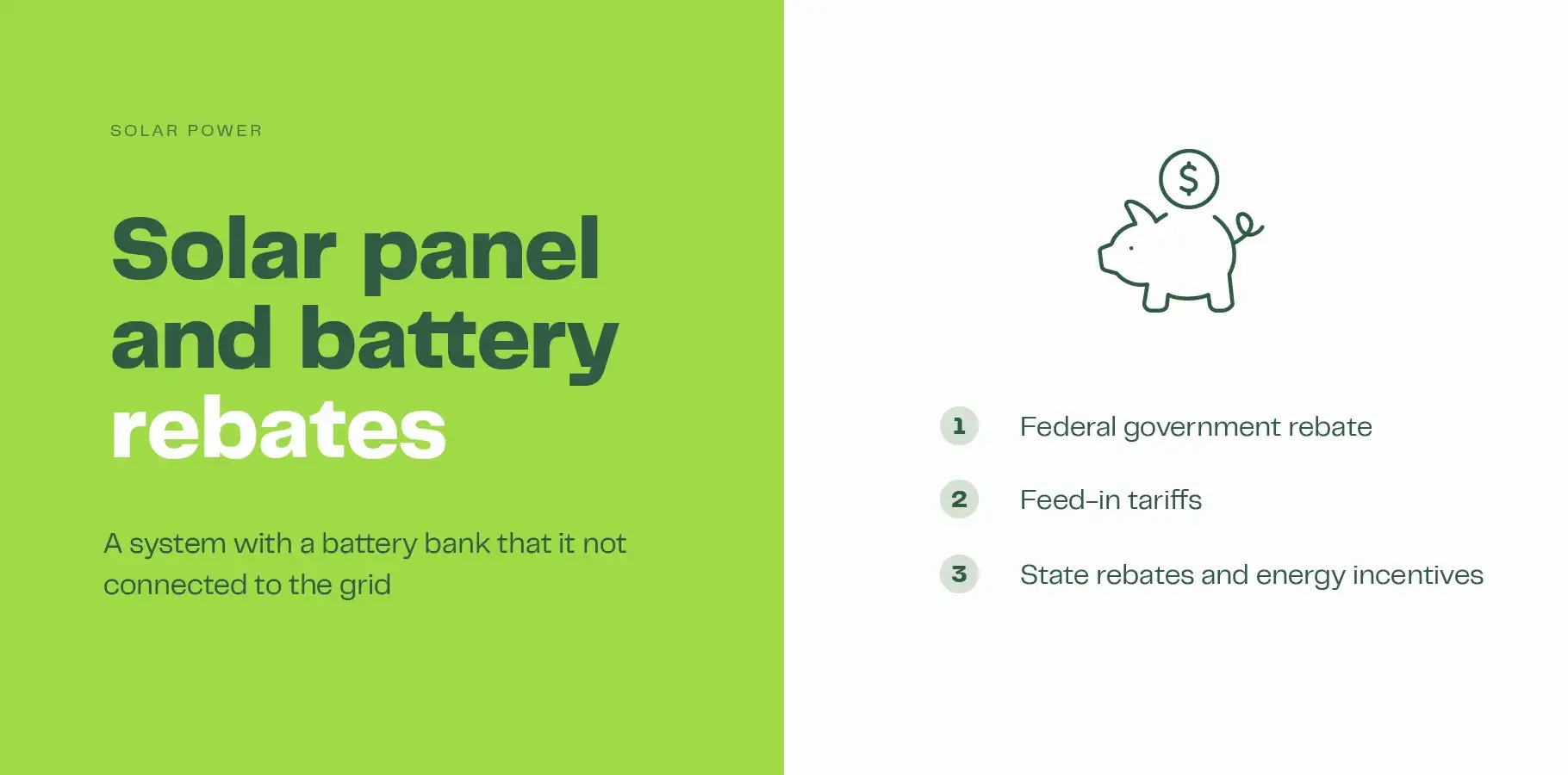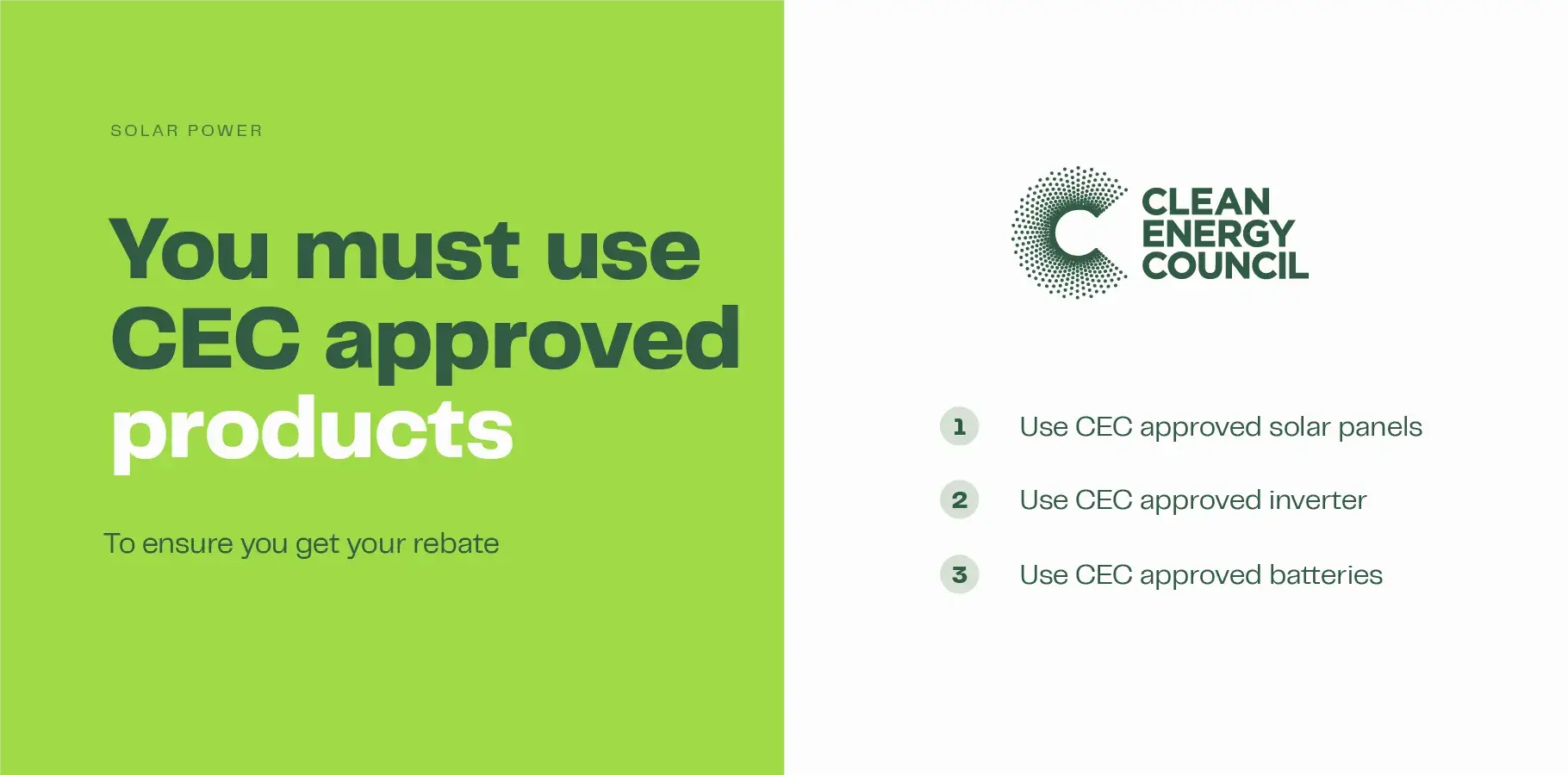The complete guide to solar panel and battery rebates in Australia – 2024
Last updated: March 2024
Reading time: 7 minutes
The price of solar has fallen dramatically in the past ten years. But still, the upfront cost of a new system is a barrier for many households.
Luckily, there’s a range of rebates and incentives on offer to help Australian households switch to renewable energy.
In this guide, we list the national solar incentives, along with state-based solar and battery rebates. We also cover the additional grants homeowners can access for energy-efficient home upgrades, and electric vehicle incentives.

National solar rebates and incentives
There are two nationwide solar incentives that homeowners can access: the federal solar rebate scheme and solar feed-in tariffs.
Federal solar rebate scheme
The federal solar rebate scheme (formally known as the Small-Scale Renewable Energy Scheme rewards your solar system with Small-scale Technology Certificates (STCs) based on its size, location, and estimated energy production. The larger the projected energy production, the more STCs your system will receive.
The national solar rebate is set to end in 2030. The rebate decreases each calendar year, until it is fully phased out in 2030.
Your solar installer will calculate the total value of these STCs and subtract the amount from your installation cost.
How much can I save with the federal solar rebate?
The federal solar rebate can reduce the cost of your solar panels by up to a third.
The exact amount depends on your system size, the solar rating of your local area, and how soon you install your new system.
We list example rates for each state below, or you can use our free STC Calculator to work out your rebate value.
Solar feed-in tariffs
The solar feed-in tariff is a payment for exporting unused solar energy to the grid. It’s not a one-time payment, but ongoing credits you will receive on your electricity bills.
The rates differ across the country: some state governments set fixed rates while others leave it to electricity providers to set competitive rates.
Check the rates in your state below, or visit our guide to solar feed-in tariffs.
Are there any national rebates available for solar batteries?
The short answer is no – there is no nationwide solar battery incentive.
States and territories vary in what they offer, from battery rebates to loans. See our guide to solar battery rebates for detailed information on every state and territory. You can also check what’s available in your particular state below.
State-by-state solar and battery incentives
Solar rebates NSW
Here’s what’s on offer across New South Wales:
- Federal government solar rebate: In Newcastle, an average-sized system of 6.6kW can attract a rebate of approximately $2,520.
- Feed-in tariffs: Rates in NSW range between 5c and 15.0c per kilowatt hour, depending on your electricity provider.
- Rebate swap for solar: Households on the Low Income Household Rebate can swap this benefit for a free 3kW solar system.
- Energy savings scheme: Upgrade different systems in your home to be more energy-efficient and receive a discount on the cost. Systems include lighting, air conditioning, hot water, and pool pumps.
- EV ready buildings grant: Fit out your apartment with EV charging infrastructure with a grant of up to $80,000.
Check out all the details on solar incentives in NSW.
Solar rebates VIC
Here’s what’s on offer across Victoria:
- Federal government solar rebate: An average-sized system of 6.6kW can attract a rebate of approximately $2,500 in Victoria.
- Feed-in tariffs: Victorians can choose between a fixed flat rate of at least 4.9c per kilowatt hour or one of two time-varying options with a range of 3.9c to 11.3c, depending on the time of day.
- Victorian Solar panel (PV) rebate: Receive a discount of up to $1,400 for new solar panel systems or to upgrade/replace systems that are over ten years old. You can also apply for an interest-free loan up to the same amount.
- Solar rebates for rental properties: Get up to $1,400 off new solar panel systems for your rental properties, with a limit of two per financial year. Interest-free loans up to the same amount are also available.
- Solar battery loans: Take out an interest-free loan of up to $8,800 to add a battery to your existing system, or to install a battery as part of a new system.
- Hot water rebate: Get up to $1,000 off eligible heat pumps and hot water systems.
- Victorian Energy Upgrades (VEU) program: Replace old appliances with energy-efficient models, upgrade your pool pump, or switch to a more energy-efficient heating, cooling, or hot water system and enjoy a state-funded discount.
Check out all the details on solar incentives in Victoria.
Solar rebates QLD
Here’s what’s on offer across Queensland:
- Federal government solar rebate: An average-sized system of 6.6kW can attract a rebate of approximately $2,500 in Queensland.
- Feed-in tariffs: Rates in South East Queensland are set by electricity retailers, whilst homes in regional Queensland will receive a flat rate of 13.441c per kWh.
- Queensland Battery Booster program: Receive up to $3,000 through the standard rebate, or $4,000 through the low-income rebate, when you install a battery for your new or existing home solar system..
- Queensland Zero Emission Vehicle Rebate Scheme: Get a $6000 rebate when you buy a new electric vehicle with a maximum dutiable value of $68,000.
Check out all the details on solar incentives in Queensland.
Solar rebates WA
Here’s what’s on offer across Western Australia:
- Federal government solar rebate: An average-sized system of 6.6kW can attract a rebate of approximately $2,520 in Western Australia.
- Feed-in tariffs: The rate in Perth is set at 2.25c per kWh during off-peak times and 10.0c during peak periods. The rates in regional WA are slightly better, depending on your location.
- Zero Emission Vehicle (ZEV) Rebate Scheme: Get a $3,500 rebate for purchasing a new all-electric vehicle.
Check out all the details on solar incentives in Western Australia.
Solar rebates SA
Here’s what’s on offer across South Australia:
- Federal government solar rebate: An 8.5kW system can attract a rebate of approximately $3,200 in South Australia.
- Feed-in tariffs: Rates in SA range between 3.5c and 8.5c per kWh, depending on your electricity provider.
Homeowners in the City of Adelaide can access additional incentives: - Residential Solar PV rebate: Concession card holders, tenanted, or strata-managed residential properties can access discounts for new solar systems.
- Energy Storage Systems rebate: Receive a 50% rebate, up to $2,000, off a new solar battery.
- Shared Solar rebate: Receive a 20% rebate, up to $20,000 per site, for a shared solar system.
- Appliance electrification: Receive a 50% rebate, up to $1,000, when you replace gas or wood-burning appliances with electric or solar-powered ones.
- Electric vehicle charging stations: Receive up to $2,000 off the installation cost of an electric bicycle or electric vehicle charging station.
Check out all the details on solar incentives in South Australia.
Solar rebates TAS
Here’s what’s on offer across Tasmania:
- Federal government solar rebate: An average-sized system of 6.6kW can attract a rebate of approximately $2,000 in Tasmania.
- Feed-in tariffs: The rate in Tasmania is locked in at 10.869c/kWh until June 2024.
- Energy Saver Loan scheme: Get an interest-free loan of up to $10,000 to help with an energy-efficiency project. Eligible projects include new solar systems, solar battery storage, home EV chargers, and other home upgrades. You can find more details on the Energy Saver Loan scheme website.
- Electric vehicle rebate: Get up to $2,000 for the purchase of an all-electric vehicle. New vehicles and used vehicles that are newly registered in Tasmania are both eligible.
- E-mobility rebates: Get a $250 rebate for e-scooters and skateboards, $500 for e-bikes, and $1,000 for cargo e-bikes.
Solar rebates ACT
Here’s what’s on offer across the Australian Capital Territory:
- Federal government solar rebate: An average-sized system of 6.6kW can attract a rebate of approximately $2,500 in the Australian Capital Territory.
- Feed-in tariffs: Rates in the ACT range between 6c – 15c per kWh, depending on your retailer.
- Home Energy Support rebate: Get up to $2,500 off the installation cost of a new solar system, reverse cycle heating and cooling, hot water heat pump, electric stove and oven, or ceiling insulation. This rebate is available only to holders of an Australian Government Pensioner Concession Card, a Department of Veterans’ Affairs Gold Card, or an Australian Government Health Care Card. The details can be found here.
- Sustainable Household Scheme loans: Get an interest-free loan of up to $15,000 for a range of projects, including new household solar systems, solar battery storage, home energy upgrades, and electric vehicles. Details can be found on the Sustainable Household Scheme website.
- Electric vehicle incentives: Enjoy two years of free registration and no stamp duty on different low- and zero-emission vehicles. View all the details at the Access Canberra website.
Solar rebates NT
Here’s what’s on offer across the Northern Territory:
- Federal government solar rebate: An average-sized system of 6.6kW can attract a rebate of approximately $2,800 in the Northern Territory.
- Feed-in tariffs: Rates in NT range between 8.3c and 11.0c per kWh, depending on your retailer.
- Home and Business Battery Scheme: Get a grant of up to $5,000 to install an inverter and battery with a new solar system or to add a battery and inverter to an existing system. View all the details here.
- Electric vehicle incentives: Enjoy free registration for new and used EVs, get up to $1,500 stamp duty concession, and install a new home charger with a grant of up to $1,000.
Tips to get the most out of solar rebates and incentives
Understand the process before you start
Knowing the rebates you’re eligible for before starting your solar project helps ensure you don’t miss out.
Some incentives require pre-approval before installing your new solar system. We advise you to check the incentives outlined for your state in the list above and research the criteria before you accept a quote and begin your solar project.
Combine different offers
Lots of the state-based offers listed in this article can be combined with the national solar rebate, so it pays to apply for everything you might be eligible for.
Work with a reputable installer
A good solar installer will guide you through your application process and make your claims easier. We handpick every company we work with, so you can rest easy that any quote you receive through our site will lead to top-tier service.
Choose approved products
Many of the rebates listed above – including the federal solar rebate – require you to use CEC-approved parts in your solar system. Choosing from the approved list specified for each incentive will ensure your system’s eligibility and guarantee its high quality.
You can view the approved list here.

Next steps
If learning about these rebates has made your solar dream seem more achievable, here are the next steps you can take:
- Use our simple STC calculator to work out how much the federal solar rebate will save you.
- Read our tips for choosing the best solar installer.
- Learn about financing your solar system.

Are you ready for the benefits of solar?
Get 3 free quotes and start your journey towards making the switch.
Get free quotes